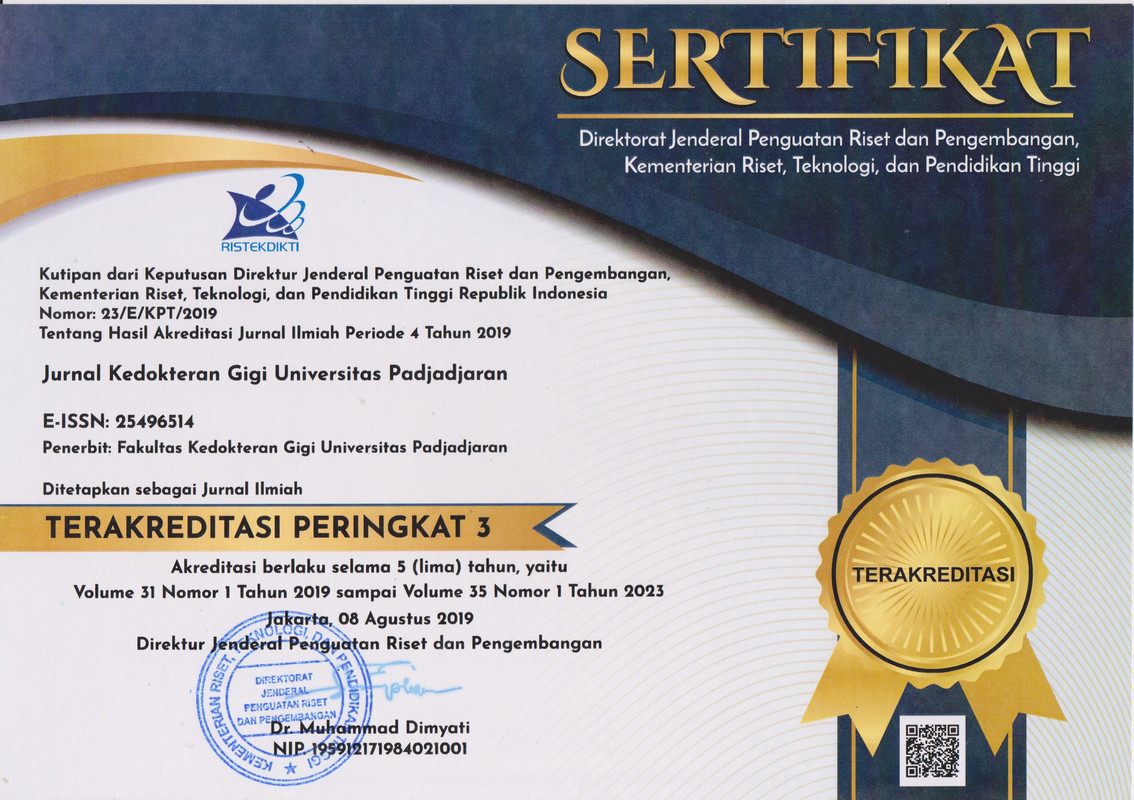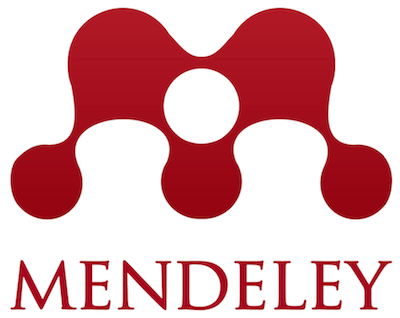Correlation between posterior tooth loss and temporomandibular joint disorders in elders: A cross-sectional study
Abstract
Introduction: Tooth loss is one of the essential factors of oral health status, which affects individual quality of life and social factors. It is also a common oral health problem in adults and elders. A prolonged period of tooth loss, followed by an immediate replacement with dentures, can cause changes in occlusion due to the teeth' unsustainability; tooth position shift followed by extrusion leads to occlusion pattern disruption, resulting in gingival movement difficulties. This research analyses the correlation between posterior tooth loss and temporomandibular joint disorders in elders. Methods: Analytic observational with cross-sectional study. The sampling technique was simple random sampling, identifying a population of 39 people aged 60 to 75, consisting of 12 males and 27 females. The sample size was determined by the overall population size, calculated through the minimum single sample size formula incorporating the correlation coefficient (r). The primary data was obtained by completing the questionnaires and the respondents' clinical examination with the Helkimo index. Results: The findings showed that most respondents were female, 27 compared to 12. In terms of dysfunctional index data for tooth loss, the "Mild symptoms" were found to be predominant over "No symptoms", with the (HG) ≤ 4; while the (HG) ≥ 4, showed that the "No symptoms" were less common. Similarly, in the anamnesis index data, the "Mild symptoms" were the most common, with the (HG) ≤ 4; while the (HG) ≥ 4 showed that the "No symptoms" was predominated, with fewer cases of the "Mild symptoms" and the "Severe symptoms". The Spearman Correlation Rank test analysis showed that the r (coefficient of correlation) = 0,944, with p = 0.000. Conclusion: There is a relationship between posterior tooth loss and temporomandibular joint disorders in elders.
Keywords
Full Text:
PDFReferences
REFERENCES
Dwipayanti AN, Parnaadji RR, Kiswaluyo K. Hubungan antara kehilangan gigi posterior dengan kliking sendi temporomandibular berdasarkan jenis kelamin di klinik prostodonsia rumah sakit gigi dan mulut universitas jember. Pustaka Kes. 2017;4(3):507-513.
Bolerázska B, Krotký R, Kluknavská J, Timková S, Vašková J. Connections between tooth loss and adequate nutrition. Med Sci. 2020;24(104):2234-44.
Ratnasari D, Isnaeni RS, Fadilah RPN. Kebersihan gigi tiruan lepasan pada kelompok usia 45-65 tahun removable denture cleanliness in the 45-65 years age group. Padj J Dent Res Stud. 2019; 3(2): 87-91. DOI: 10.24198/pjdrs.v3i2.23573
James A, Janakiram C, Meghana RV, Kumar VS, Sagarkar AR. Impact of oral conditions on oral health-related quality of life among indians-a systematic review and meta-analysis. Heal Quality Life Outcomes. 2023;21(1):1-18. DOI: 10.1186/s12955-023-02170-6
Hamasaki T, Kato H, Kumagai T, Hagihara A. Association between dentist–dental hygienist communication and dental treatment outcomes. Heal Community. 2017;32(3):288-97. DOI: 10.1080/10410236.2016.1138376
Horst OV, Cunha-Cruz J, Zhou L, Manning W, Mancl L, DeRouen TA. Prevalence of pain in the orofacial regions in patients visiting general dentists in the Northwest Practice-based REsearch Collaborative in Evidence-based DENTistry research network. J Am Dent Assoc. 2015;146(10):721-8.e3. DOI: 10.1016/j.adaj.2015.04.001.
Manu AA, Nubatonis MO, Variani R. Studi tentang perbedaan berat badan antara manula dengan kehilangan gigi geligi posterior bilateral free-end dan manula yang masih memiliki gigi geligi posterior di Kelurahan Camplong I. J Info Kes. 2014;12(1): 557-65. DOI: 10.31965/infokes.v12i1.40
Lin HK, Pan YH, Salamanca E, Lin YT, Chang WJ. prevention of bone resorption by ha/β-tcp + collagen composite after tooth extraction: a case series. Int J Environ Res Public Health. 2019; 16(23): 4616. DOI: 10.3390/ijerph16234616.
Siagian KV. kehilangan sebagian gigi pada rongga mulut. J Eclinic. 2016; 4(1): 107-11. DOI: 10.35790/ecl.v4i1.12316
Triana A, Rahmi E, Fransiska A. Hubungan stres dengan temporomandibular disorder pada narapidana di lembaga pemasyarakatan perempuan kelas ii b padang. Andalas Dent J. 2020;8(2):74-82. DOI: 10.25077/adj.v8i2.202
Munte RS, Risnita R, Jailani MS, Siregar I. Jenis penelitian eksperimen dan noneksperimen. J Pend Tambusai. 2023;7(3):27602-6. DOI: 10.31004/jptam.v7i3.11128
Hafni Sahir S, Koryati T, Kreatif P, Rochmah A. Metodologi Penelitian. Repositori UMA. 2021; 1(1) 7-76. Available at: www.penerbitbukumurah.com
Gul M, Kamal R, Inayat A, Kasi MZ. Relationship between maternal hemoglobin concentration to newborn cbh and serum concentration: a cross sectional study. World J Pharmac Res. 2022;11(2):1-7. DOI: 10.20959/wjpr20222-22668
Ali Abd Al-Hameed K. Spearman's correlation coefficient in statistical analysis. Int J Nonlinear Analysis Applications. 2022; 13(1): 3249-55. DOI: 10.22075/IJNAA.2022.6079
Fernández-de-Las-Peñas C, Von Piekartz H. Clinical reasoning for the examination and physical therapy treatment of temporomandibular disorders (TMD): a narrative literature review. J Clin Med. 2020; 9(11): 3686. DOI: 10.3390/jcm9113686.
Rani S, Pawah S, Gola S, Bakshi M. Analysis of helkimo index for temporomandibular disorder diagnosis in the dental students of faridabad city: a cross sectional study. J Indian Prosthodont Soc. 2017; 17(1): 48-52. DOI: 10.4103/0972-4052.194941.
Nokar, Saeid, et al. Evaluation of signs, symptoms, and occlusal factors among patients with temporomandibular disorders according to helkimo index. cranio: J Craniomandi Practice. 2018;37(1):1-6. DOI: 10.1080/08869634.2018.1449781.
Pratiwi T, Sinamo S, Paulina Gultom H. Prevalensi kehilangan gigi posterior unilateral dibandingkan dengan bilateral terhadap gangguan sendi temporomandibula pada lanjut usia. Prima J Oral Dent Sci. 2018; 1(2): 39-44.
Ved VP, Arora A, Das D, Kalra D. The correlation of unilateral chewing habit with temporomandibular joint disorders. international journal of scientific study. 2017;5(1):1-4. DOI: 10.17354/ijss/2017/144
Isnaeni RS, Patria A, Silvana IR. Relationship of one side chewing habits to temporomandibular joint disorders occurrence. journal of health and dental sciences. 2022; 2(2): 279-302. DOI: 10.54052/jhds.v2n2.p279-302
Gabrila J, Tendean L, Zuliari K. Description of temporomandibular disorders in the elderly in wanea district. E-Dental J. 2016;4(2): 91-4. DOI: 10.35790/eg.4.2.2016.13489
Shet RG, Yadav RD, Rao S, Patel R, Suvvati P, Sadar LR. Prevalence of Temporomandibular Joint Dysfunction and Its Signs among the Partially Edentulous Patients in a Village of North Gujarat. J Contemporary Dent Prac. 2014; 14(6): 1151-5. DOI: 10.5005/jp-journals-10024-1466
Andesty D, Syahrul F. The relationship between social interaction and the quality of life of the elderly in the integrated service unit (UPTD) Griya Werdha, Surabaya City, 2017. Ind J Pub Heal. 2018; 13(2): 169-80. DOI: 10.20473/ijph.vl13il.2018.169
Jankovic N, Geelen A. Adherence to a Healthy Diet According to the World Health Organization Guidelines and All-Cause Mortality in Elderly Adults from Europe and the United States. Am J Epidemiol. 2014;180(10): 978-88. DOI: 10.1093/aje/kwu229
Gabrila J, Tendean L, Zuliari K. Gambaran temporomandibular disorders pada lansia di kecamatan wanea. eG. 2016;4(2). DOI: /10.35790/eg.4.2.2016.13489
Sihombing R. Hubungan kehilangan gigi sebagian terhadap gangguan sendi temporomandibula pada pasien RSGM FKG USU. The Journal. 2015;1(2):1-68. DOI: 10.35790/eg.4.2.2016.13489
Isnaeni RS, Patria A, Silvana IR. Relationship of One Side Chewing Habits to Temporomandibular Joint Disorders Occurrence. Journal of Health and Dental Sciences. 2022;2(2):279-302. DOI: 10.54052/jhds.v2n2.p279-302
Florczak KL. Best available evidence or truth for the moment: bias in research. Nursing Scie Quart. 2022;35(1):20-24. DOI:10.1177/08943184211051350
Hanin I, Putri PW. Relationship of temporomandibular joint disorders and psychological distress in young adults. J Syiah Kuala Dentis Soc. 2023;20;8(1):55-60.
Chisnoiu AM, Picos AM, Popa S, Chisnoiu PD, Lascu L, Picos A, et al. Factors Involved in the Etiology of Temporomandibular Disorders – A Literature Review. Clujul Med 2015;88(4):473-8. DOI: 10.15386/cjmed-485
DOI: https://doi.org/10.24198/jkg.v36i1.53439
Refbacks
- There are currently no refbacks.
Copyright (c) 2024 Jurnal Kedokteran Gigi Universitas Padjadjaran
INDEXING & PARTNERSHIP

Jurnal Kedokteran Gigi Universitas Padjadjaran dilisensikan di bawah Creative Commons Attribution 4.0 International License






.png)

















